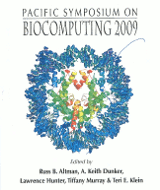Dissecting the Interface Between Signaling and Transcriptional Regulation in Human B Cells
Kai Wang1,2, Mariano J. Alvarez2, Brygida C. Bisikirska2, Rune Linding3, Katia Basso4, Riccardo Dalla Favera4, and Andrea Califano1,2,4
1Department of Biomedical Informatics, Columbia University, New York, NY, USA; 2 Joint Centers for Systems Biology, Columbia University, New York, NY, USA; 3Samuel Lunenfeld Research Institute, Mount Sinai Hospital, Toronto, Canada; 4Institute of Cancer Genetics, Columbia University, New York, NY, USA
Email: califano@c2b2.columbia.edu
Pacific Symposium on Biocomputing 14:264-275(2009)

Abstract
A key role of signal transduction pathways is to control transcriptional programs in the nucleus as a function of signals received by the cell via complex post-translational modification cascades. This determines cell-context specific responses to environmental stimuli. Given the difficulty of quantitating protein concentration and post-translational modifications, signaling pathway studies are still for the most part conducted one interaction at the time. Thus, genome-wide, cell-context specific dissection of signaling pathways is still an open challenge in molecular systems biology.
In this manuscript we extend the MINDy algorithm for the identification of post-translational modulators of transcription factor activity, to produce a first genome-wide map of the interface between signaling and transcriptional regulatory programs in human B cells. We show that the serine-threonine kinase STK38 emerges as the most pleiotropic signaling protein in this cellular context and we biochemically validate this finding by shRNA-mediated silencing of this kinase, followed by gene expression profile analysis. We also extensively validate the inferred interactions using protein-protein interaction databases and the kinase-substrate interaction prediction algorithm NetworKIN.
[Full-Text PDF] [PSB Home Page]